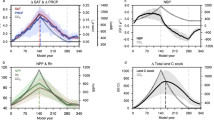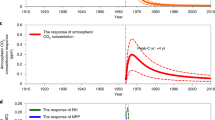Abstract
Atmospheric concentrations of the three important greenhouse gases (GHGs) CO2, CH4 and N2O are mediated by processes in the terrestrial biosphere that are sensitive to climate and CO2. This leads to feedbacks between climate and land and has contributed to the sharp rise in atmospheric GHG concentrations since pre-industrial times. Here, we apply a process-based model to reproduce the historical atmospheric N2O and CH4 budgets within their uncertainties and apply future scenarios for climate, land-use change and reactive nitrogen (Nr) inputs to investigate future GHG emissions and their feedbacks with climate in a consistent and comprehensive framework1. Results suggest that in a business-as-usual scenario, terrestrial N2O and CH4 emissions increase by 80 and 45%, respectively, and the land becomes a net source of C by AD 2100. N2O and CH4 feedbacks imply an additional warming of 0.4–0.5 °C by AD 2300; on top of 0.8–1.0 °C caused by terrestrial carbon cycle and Albedo feedbacks. The land biosphere represents an increasingly positive feedback to anthropogenic climate change and amplifies equilibrium climate sensitivity by 22–27%. Strong mitigation limits the increase of terrestrial GHG emissions and prevents the land biosphere from acting as an increasingly strong amplifier to anthropogenic climate change.
This is a preview of subscription content, access via your institution
Access options
Subscribe to this journal
Receive 12 print issues and online access
$209.00 per year
only $17.42 per issue
Buy this article
- Purchase on Springer Link
- Instant access to full article PDF
Prices may be subject to local taxes which are calculated during checkout





Similar content being viewed by others
References
Gregory, J. M., Jones, C. D., Cadule, P. & Friedlingstein, P. Quantifying carbon cycle feedbacks. J. Clim. 22, 5232–5250 (2009).
Canadell, J. G. et al. Contributions to accelerating atmospheric CO2 growth from economic activity, carbon intensity, and efficiency of natural sinks. Proc. Natl Acad. Sci. USA 104, 18866–18870 (2007).
Hirsch, A. et al. Inverse modelling estimates of the global nitrous oxide surface flux from 1998–2001. Glob. Biogeochem. Cycles 20, GB1008 (2006).
Davidson, E. A. The contribution of manure and fertilizer nitrogen to atmospheric nitrous oxide since 1860. Nature Geosci. 2, 659–662 (2009).
Denman, K. L. et al. in IPCC Climate Change 2007: The Physical Science Basis (eds Solomon, S. et al.) Ch. 7 (Cambridge Univ. Press, 2007).
Arneth, A. et al. Terrestrial biogeochemical feedbacks in the climate system. Nature Geosci. 3, 525–532 (2010).
Xu-ri Prentice, I. C., Spahni, R. & Niu, H. S. Modelling terrestrial nitrous oxide emissions and implications for climate feedback. New Phytol. 2, 472–88 (2012).
Van Groenigen, K. J., Osenberg, C. W. & Hungate, B. A. Increased soil emissions of potent greenhouse gases under increased atmospheric CO2 . Nature 475, 214–216 10.1038/nature10176(2011).
Khalil, M. A. K. & Rasmussen, R. A. Climate-induced feedbacks for the global cycles of methane and nitrous oxide. Tellus B 41B, 554–559 10.1111/j.1600-0889.1989.tb00141.x(1989).
Torn, M. S. & Harte, J. Missing feedbacks, asymmetric uncertainties, and the underestimation of future warming. Geophys. Res. Lett. 33, L10703 (2006).
Frank, D. C. et al. Ensemble reconstruction constraints on the global carbon cycle sensitivity to climate. Nature 463, 527–530 (2010).
Knutti, R. & Hegerl, G. C. The equilibrium sensitivity of the Earth’s temperature to radiation changes. Nature Geosci. 1, 735–743 (2008).
Sitch, S. et al. Evaluation of ecosystem dynamics, plant geography and terrestrial carbon cycling in the LPJ dynamic global vegetation model. Glob. Change Biol. 9, 161–185 (2003).
Strassmann, K. M., Joos, F. & Fischer, G. Simulating effects of land use changes on carbon fluxes: Past contributions to atmospheric CO2 increases and future commitments due to losses of terrestrial sink capacity. Tellus B 60, 583–603 (2008).
Wania, R., Ross, I. & Prentice, I. C. Integrating peatlands and permafrost into a dynamic global vegetation model: 2. Evaluation and sensitivity of vegetation and carbon cycle processes. Glob. Biogeochem. Cycles 23 10.1029/2008GB003413(2009).
Xu-Ri, & Prentice, I. C. Terrestrial nitrogen cycle simulation with a dynamic global vegetation model. Glob. Change Biol. 14, 1745–1764 (2008).
Spahni, R., Joos, F., Stocker, B. D., Steinacher, M. & Yu, Z. C. Transient simulations of the carbon and nitrogen dynamics in northern peatlands: from the Last Glacial Maximum to the twenty first century. Clim. Past Discuss. 8, 5633–5685 (2012).
Zürcher, S., Spahni, R., Joos, F., Steinacher, M. & Fischer, H. Impact of an 8.2-kyr-like event on methane emissions in northern peatlands. Biogeosci. Discuss. 9, 13243–13286 (2012).
Spahni, R. et al. Constraining global methane emissions and uptake by ecosystems. Biogeosciences 8, 1643–1665 (2011).
Stocker, B. D., Strassmann, K. & Joos, F. Sensitivity of Holocene atmospheric CO2 and the modern carbon budget to early human land use: Analyses with a process-based model. Biogeosciences 8, 69–88 (2011).
Mitchell, T. D. & Jones, P. D. An improved method of constructing a database of monthly climate observations and associated high-resolution grids. Int. J. Climatol. 25, 693–712 (2005).
MacFarling Meure, C. et al. Law Dome CO2, CH4 and N2O ice core records extended to 2000 years BP. Geophys. Res. Lett. 33, L14810 (2006).
Lamarque, J-F. et al. Global and regional evolution of short-lived radiatively-active gases and aerosols in the representative concentration pathways. Climatic Change 109, 191–212 (2011).
Zaehle, S., Ciais, P., Friend, A. D. & Prieur, V. Carbon benefits of anthropogenic reactive nitrogen offset by nitrous oxide emissions. Nature Geosci. 4, 601–605 (2011).
Van Vuuren, D. P. et al. RCP2.6: Exploring the possibility to keep global mean temperature increase below 2 °C. Climatic Change 109, 95–116 (2011).
Riahi, K. et al. RCP 8.5-A scenario of comparatively high greenhouse gas emissions. Climatic Change 109, 33–57 (2011).
De Klein, C. et al. in IPCC Guidelines for National Greenhouse Gas Inventories Vol. 4 (eds Eggleston, H., Buendia, L., Miwa, K., Ngara, T. & Tanabe, K.) Ch. 11 (IGES, 2006).
Müller, S. A., Joos, F., Edwards, N. R. & Stocker, T. F. Water mass distribution and ventilation timescales in a cost-efficient, three-dimensional ocean model. J. Clim. 19, 5479–5499 (2006).
Ritz, S. P., Stocker, T. F. & Joos, F. A coupled dynamical ocean energy balance atmosphere model for paleoclimate studies. J. Clim. 24, 349–375 (2011).
Prentice, I. C. et al. Modelling fire and the terrestrial carbon balance. Glob. Biogeochem. Cycles 25, GB3005 (2011).
Suntharalingam, P. et al. Quantifying the impact of anthropogenic nitrogen deposition on oceanic nitrous oxide. Geophys. Res. Lett. 39, L07605 (2012).
Joos, F. et al. Global warming feedbacks on terrestrial carbon uptake under the Intergovernmental Panel on Climate Change (IPCC) emission scenarios. Glob. Biogeochem. Cycles 15, 891–907 (2001).
Langenfelds, R. et al. in Baseline Atmospheric Program Australia (eds Cainey, J., Derek, N. & Krummel, P.) 55–56 (Bureau of Meteorology and CSIRO Atmospheric Research, 2004).
Buizert, C. et al. Gas transport in firn: Multiple-tracer characterization and model intercomparison for NEEM, Northern Greenland. Atmos. Chem. Phys. 12, 4259–4277 (2012).
Acknowledgements
We acknowledge K. Riahi for providing RCP8.5 data, J-F. Lamarque for providing N-deposition data, climate modelling centres participating in CMIP5 as listed in Supplementary Table S1 for providing climate input data, and C2SM at ETHZ for processing and sharing the CMIP5 data. We thank P. Friedlingstein and Th. Stocker for discussions and inputs. We appreciate support by the Swiss National Science Foundation through the National Centre of Competence in Research Climate (NCCR) and the grant to the division of Climate and Environmental Physics, and by the European Commission through the FP7 project CARBOCHANGE (grant no. 264879) and Past4Future (grant no. 243908).
Author information
Authors and Affiliations
Contributions
B.D.S. and R.R. share equal contributions to this work. B.D.S. prepared the model set-up, conducted the offline simulations, compiled the figures and wrote the text. R.R. prepared and conducted the online simulations, and delivered inputs for the model set-up and results analysis. R.S. and M.S. contributed substantially to the LPX model development and the simulations. S.Z. and L.B. provided N-fertilization and N2O input data and technical advice. X-R. contributed substantially to the LPX model development. I.C.P. and F.J. initiated the study, guided the concept and edited the manuscript text. F.J. organized funding for B.S., R.R., R.S. and M.S.
Corresponding author
Ethics declarations
Competing interests
The authors declare no competing financial interests.
Supplementary information
Supplementary Information
Supplementary Information (PDF 4488 kb)
Rights and permissions
About this article
Cite this article
Stocker, B., Roth, R., Joos, F. et al. Multiple greenhouse-gas feedbacks from the land biosphere under future climate change scenarios. Nature Clim Change 3, 666–672 (2013). https://doi.org/10.1038/nclimate1864
Received:
Accepted:
Published:
Issue Date:
DOI: https://doi.org/10.1038/nclimate1864
This article is cited by
-
Seasonality of cholera in Kolkata and the influence of climate
BMC Infectious Diseases (2023)
-
Synergistic interactions of fine particles and radiative effects in modulating urban heat islands during winter haze event in a cold megacity of Northeast China
Environmental Science and Pollution Research (2023)
-
Underutilized fruit crops in North-Western Himalayan region under changing climatic scenario
Genetic Resources and Crop Evolution (2023)
-
Past rapid warmings as a constraint on greenhouse-gas climate feedbacks
Communications Earth & Environment (2022)
-
Reactive halogens increase the global methane lifetime and radiative forcing in the 21st century
Nature Communications (2022)



